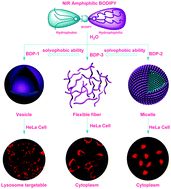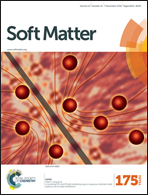Amphiphilic BODIPY derivatives: the solvophobic effect on their photophysical properties and bioimaging in living cells†
Abstract
Three novel amphiphilic BODIPY derivatives were prepared and their photophysical properties in THF/water mixtures with varying fractions of water were investigated. BDP-1 could self-assemble into different vesicle architectures in aqueous solution, while BDP-2 and BDP-3 with more hydrophilic abilities formed spherical and worm-like micelles. The BODIPY derivatives could be absorbed by HeLa cells and showed no apparent toxicity during the course of the test. In particular, unlike traditional amines or morpholinyl functionalized lysosome fluorescent probes, BDP-1 nanovesicles without targeted groups exhibit red emission and show effective lysosome biological imaging. Co-staining experiments with lysosome specific trackers further confirmed the disassembly of BDP-1 nanovesicles in lysosomes. This research provides a new avenue of using probes without targeting the structural unit to stain special organelles and shows potential applications in cell imaging fields.


 Please wait while we load your content...
Please wait while we load your content...